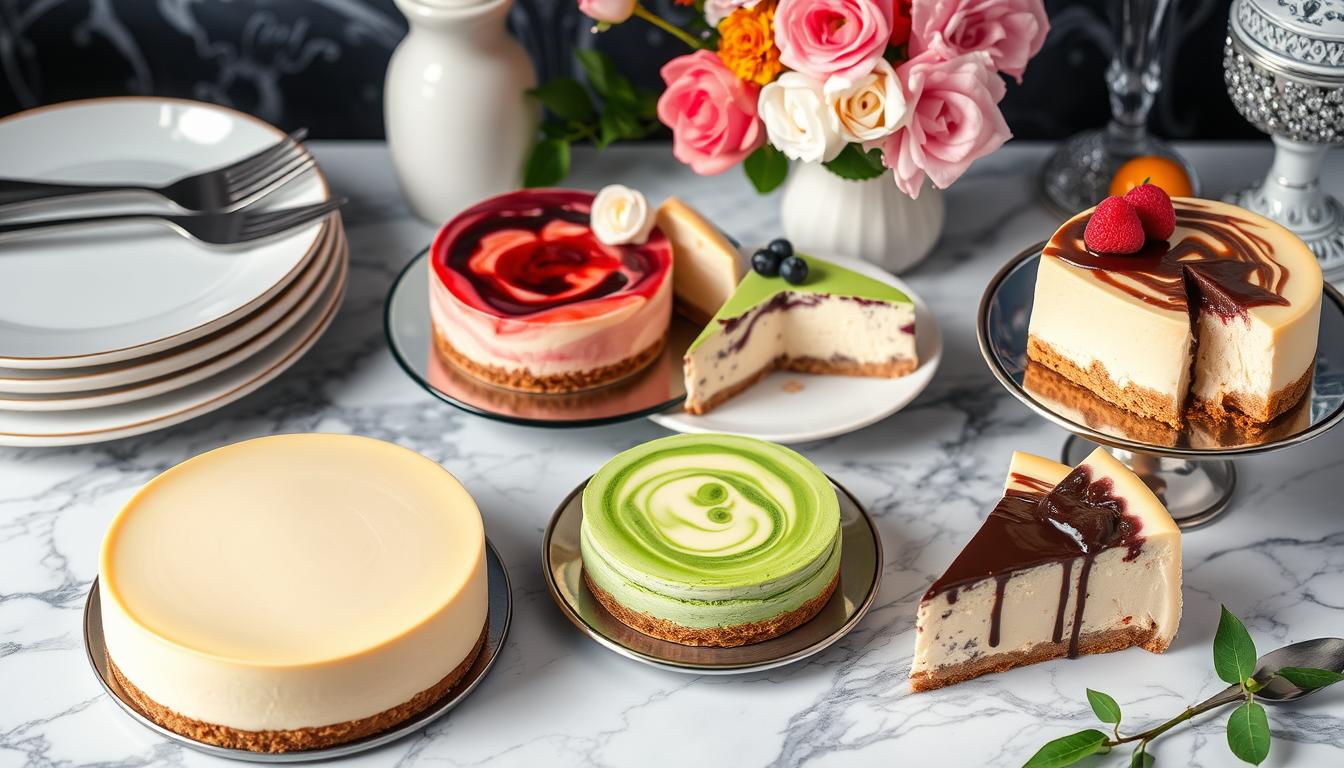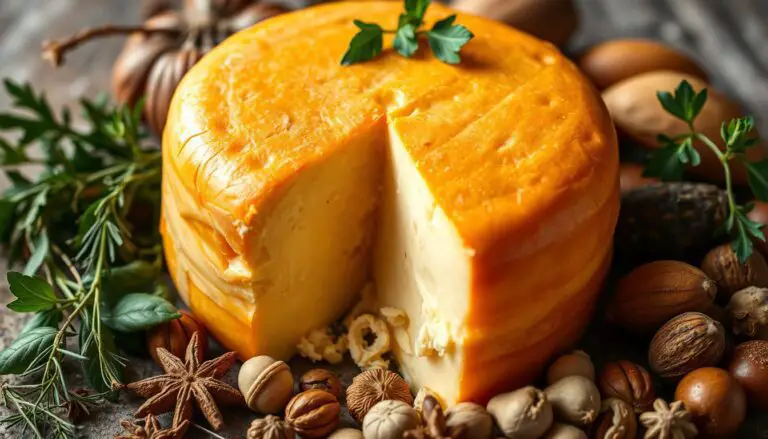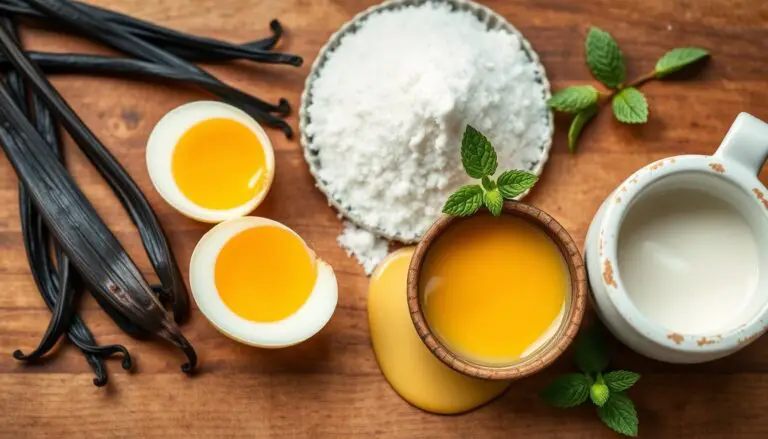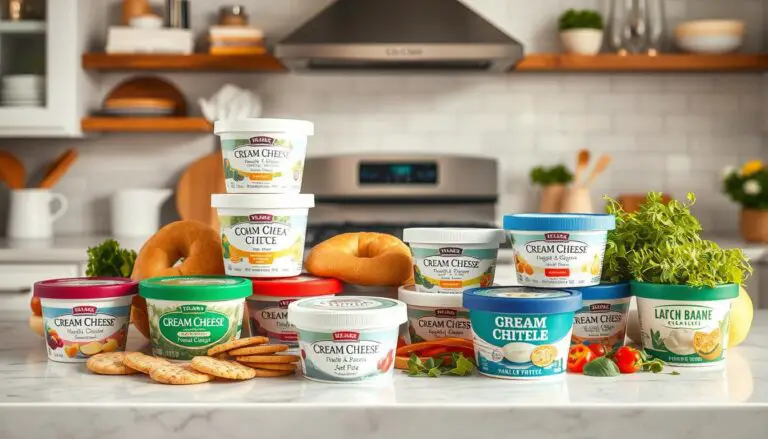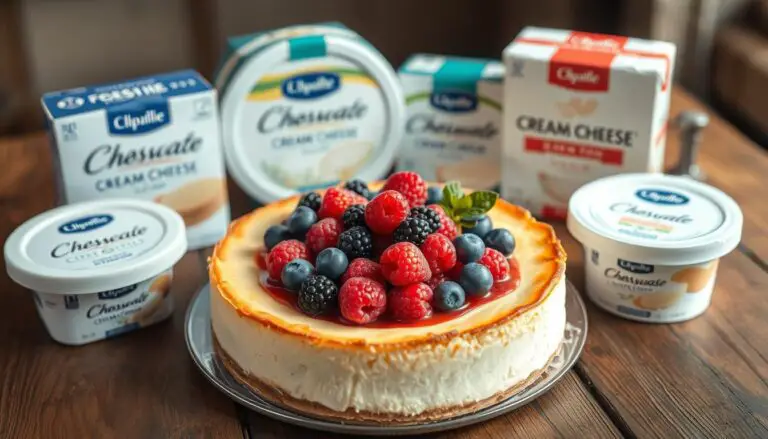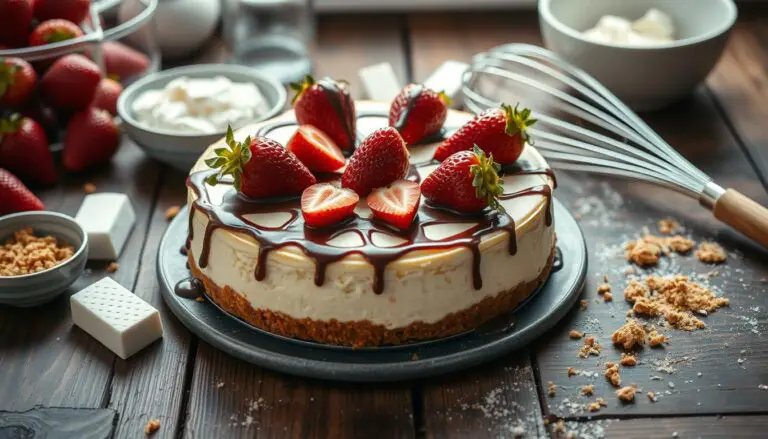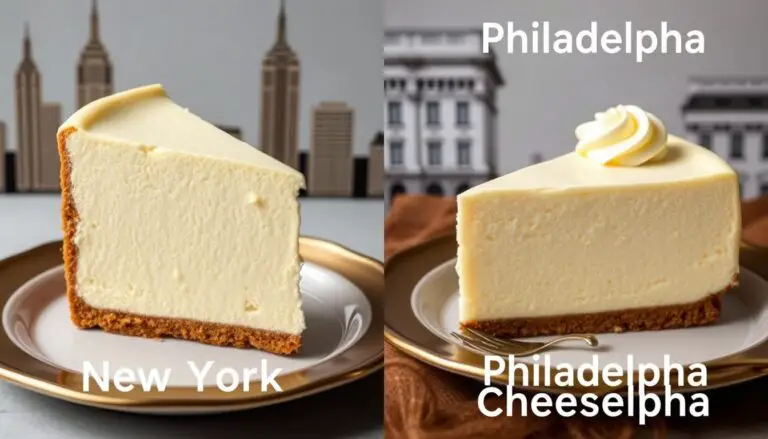Classic Cheesecake vs. Modern Variations: A Comparison
Cheesecake is a beloved dessert, known for its creamy texture and rich flavors. It has a long history, with traditional recipes leading to new, exciting flavors. From the dense New York-style to the light Japanese souffle, cheesecake has evolved, blending different styles and tastes.
Key Takeaways
- Classic cheesecake is rooted in rich tradition, while modern variations explore innovative flavors.
- Examine the ingredients, like the 40 ounces of cream cheese in traditional recipes, that define classic cheesecakes1.
- Modern twists incorporate lighter techniques, such as the Japanese souffle cheesecake that uses whipped egg yolks2.
- The popularity of cheesecake continues globally, with unique cultural adaptations emerging.
- Exploring cheesecake recipes reveals a depth of variety, from cheesecakes requiring 6 eggs to those featuring over two pounds of cream cheese in certain styles12.
- Both classic and modern variations offer unique textures and flavors to satisfy dessert enthusiasts.
Introduction to Cheesecake
Cheesecake has a long history that goes back to ancient times. It was first enjoyed in Ancient Greece, where athletes and guests at ceremonies loved it. Archaeologists found cheese molds on Samos around 2,000 B.C., showing its enduring popularity3.
Over time, cheesecake recipes changed, influenced by many cultures. The term “cheesecake” came into use in the 15th century. By the 18th century, the dessert had evolved a lot4.
Historical Background of Cheesecake
Cheesecake’s journey continued through Roman and medieval times. During this time, it picked up new flavors and ingredients, creating regional favorites. The invention of cream cheese in 1872 by William Lawrence was a big change. It made American cheesecakes creamier4.
Today, the New York-style cheesecake is famous for its dense, creamy texture. William Lawrence, a New York dairy farmer, played a key role in making this dessert a favorite in America3.
Different Cultures’ Influence on Cheesecake
Cheesecake looks different around the world, thanks to local tastes and ingredients. Japanese cheesecake, for example, is light and airy, with flavors like strawberry and matcha4.
South Africa has a no-bake version with digestive biscuits and Amarula liqueur, showing off local flavors4.
The Basque version, without a crust, has become popular on social media. It’s made with cream cheese, eggs, heavy cream, sugar, and flour5.
Cheesecake creativity knows no bounds, from the Filipino ube cheesecake to savory options like smoked salmon cheesecake4.
What is Classic Cheesecake?
Classic cheesecake is a favorite dessert known for its creamy texture. It’s made with common ingredients that create a delightful treat. These ingredients include cream cheese, sugar, eggs, and sour cream, making it rich and smooth.
Definition and Ingredients
A classic cheesecake starts with four 8-ounce packages of cream cheese. It also includes one cup of sugar and ¼ teaspoon of vanilla extract. Large eggs, sour cream, and flour are added to make it velvety6.
The crust is made from 1.5 cups of graham cracker crumbs, ¼ cup of sugar, and half a stick of melted butter6. A 9-inch springform pan is the best choice for baking6.
Traditional Cheesecake Variants
There are baked and unbaked cheesecakes, each with its own charm. Baked cheesecakes are baked at 325°F (160°C) for about an hour and a half6. They can be topped with fruit, chocolate, or nuts.
Unbaked cheesecakes are lighter and fluffier, thanks to whipped cream or gelatin. They offer a different texture.
Different cheesecakes exist worldwide. New York-style cheesecakes are dense and creamy7. Japan has a soufflé cheesecake that’s airy. Basque cheesecakes are rich and rustic7. There’s a wide variety to try.
New York-Style Cheesecake
New York-style cheesecake is a standout in the world of desserts. It’s known for its dense and creamy texture. This is thanks to extra cream and eggs, making it different from other cheesecakes.
Characteristics and Ingredients
This iconic cheesecake has a graham cracker crust that adds a nice crunch. It’s all about finding the perfect balance of sweet and tangy. This makes for a rich and satisfying taste8.
The key ingredient is cream cheese, which makes up the base of this treat. Brands like Mama Mia have come up with Baked Cheesecake Jars. They offer flavors like Blueberry, Original, and Nutella, giving the classic a modern twist9.
Comparison to Other Cheesecakes
New York-style cheesecake is richer compared to lighter types like Philadelphia and Chicago. Eileen’s Special Cheesecake has been making unique versions since 1975. Harbs even combines a honey sponge cake base with cheesecake, offering something new8.
This comparison highlights the unique qualities of New York-style cheesecake. Even with modern twists, like Mama Mia’s jars, the classic taste remains9.
Classic Cheesecake vs. Modern Variations
The world of cheesecake is full of both old favorites and new twists. Traditional cheesecakes, like the New York style, use rich ingredients and proven baking methods. On the other hand, modern cheesecakes offer unique tastes and creative shapes, appealing to those seeking something new.
Examining the Differences
Classic cheesecakes are known for their thick and creamy texture. They’re made with cream cheese, sugar, and eggs. These simple ingredients show the traditional way of making cheesecakes.
But, modern cheesecakes are all about trying new things. They might use ingredients like Japanese cheesecake’s airy texture or Basque cheesecake’s rustic simplicity5. These new styles meet the changing tastes of people who love to try new flavors.
Market Trends in Cheesecake Variations
Today, cheesecake is all about trying new ingredients, thanks to social media. Cheesecake cakes, which mix regular cake with cheesecake, are becoming popular5. There’s also a trend for unique flavors, like baklava cheesecake, which combines classic tastes with international twists5.
These trends show how the dessert market keeps evolving. They also highlight the ongoing love for both traditional and modern cheesecakes10.
Modern Cheesecake Twists
Cheesecake has evolved, leading to many new twists. Japanese cheesecake is one, known for its airy texture. It’s perfect for those who love light desserts but still want a creamy center.
Japanese Cheesecake: Airy and Fluffy
Japanese cheesecake is light and fluffy, unlike traditional cheesecakes. It uses whipped egg whites for its airy feel. This cake is less sweet, letting the cream cheese flavor shine.
Its popularity shows a shift towards lighter, more refined desserts. It’s a favorite in modern baking.
Basque Cheesecake: Rustic Charm
Basque cheesecake has a burnt outside and a creamy inside. It’s known for its rich flavors and caramelized top. This cheesecake celebrates simplicity with just a few ingredients.
Learn more about this unique cake at this source. It highlights the beauty of this adaptation11.
No-Bake Cheesecake: A Convenient Option
No-bake cheesecake is great for those who want easy desserts. It doesn’t need baking and has a creamy texture. It’s a hit with casual bakers and families.
Many recipes add caramel or fruit purees. This makes no-bake cheesecakes even more appealing12.
Cheesecake Flavors and Toppings
The world of cheesecake is full of flavors and toppings for everyone. As people look for new tastes, making unique cheesecakes becomes easier.
Popular Flavor Innovations
Recently, cheesecake flavors have grown beyond the usual. Favorites now include pumpkin, chocolate, and Oreo. Fruity options like raspberry-swirled and peanut butter are also popular.
Feedback shows people love the New York-style cheesecake. It has many 5-star reviews, showing its quality and appeal13. This shows a desire for new and exciting flavors.
Creative Topping Ideas
Creative toppings can turn a simple cheesecake into a work of art. Strawberry and blueberries are top choices. Other great ideas include lemon curd, peach slices, and pineapple chunks for a refreshing twist.
For a treat, try chocolate ganache, caramel sauce, or dulce de leche. Adding crushed pretzels and candy bars can also surprise your taste buds. Cheesecakes can be topped with many things, like whipped cream and fruit jams, to make them even better14.
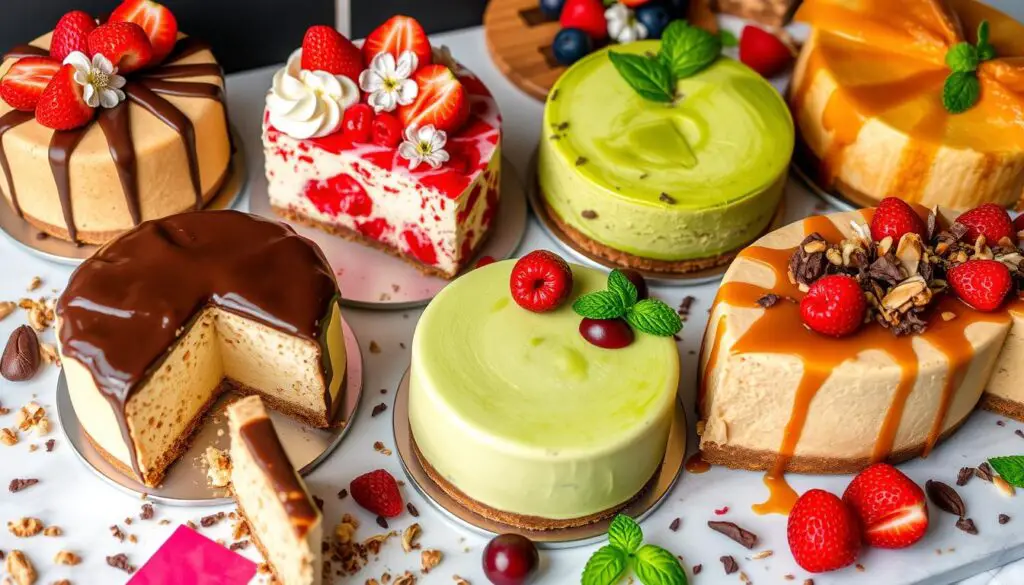
| Flavor | Description |
|---|---|
| Pumpkin | A seasonal favorite, often spiced for warmth. |
| Chocolate | Rich and decadent, appeals to chocolate lovers. |
| Oreo | Combines classic cookies and creamy cheesecake. |
| Raspberry-Swirled | Fruity and vibrant with a splash of tartness. |
| Peanut Butter | A nutty twist that adds creaminess and depth. |
Cheesecake Baking Techniques
Making the perfect cheesecake requires mastering key techniques. These methods improve both texture and taste. The water bath method is crucial for even cooking and preventing cracks.
A typical baking session lasts eight hours. It includes a two-hour bake, a two-hour rest, and a four-hour cool-down15.
Baking in a Water Bath
The water bath method, or bain-marie, is great for cheesecakes. It adds moist heat for a creamy texture. This is especially good for New York cheesecake, which uses sour cream for extra richness16.
New bakers might wonder how to know if their cheesecake is done. The “finger test” and “shake” test can help. But, checking the internal temperature is the best way. The cheesecake should reach 150 – 155°F to be done15.
The Aging Process for Depth of Flavor
Cheesecake aging is another key technique. It involves refrigerating the cheesecake for several days after baking. This process enhances flavor and texture.
New York-style cheesecake benefits a lot from aging. It becomes richer and more complex over time. So, cheesecake aging is a must for every baker17.
Texture Variations in Cheesecake
The texture of cheesecake is key to its identity, ranging from dense and creamy to light and airy. Dense cheesecakes, like the New York-style, have a rich feel. This is thanks to ingredients like heavy cream or sour cream, making them denser17. They look tall and need special care to get right.
Dense vs. Light Cheesecakes
Dense and light cheesecakes show how ingredients shape texture. A dense New York cheesecake uses a lot of cream cheese, sugar, and eggs. This makes it calorie-heavy compared to lighter ones17. Japanese cheesecakes, however, are lighter because they mix in whipped egg whites. This adds air for a fluffier taste.
Influence of Ingredients on Texture
Ingredients greatly impact cheesecake texture. Sour cream or cream cheese add richness but change density. Using ricotta instead of cream cheese makes cheesecakes lighter18. Baking in a water bath helps even out the bake, avoiding cracks and improving texture.
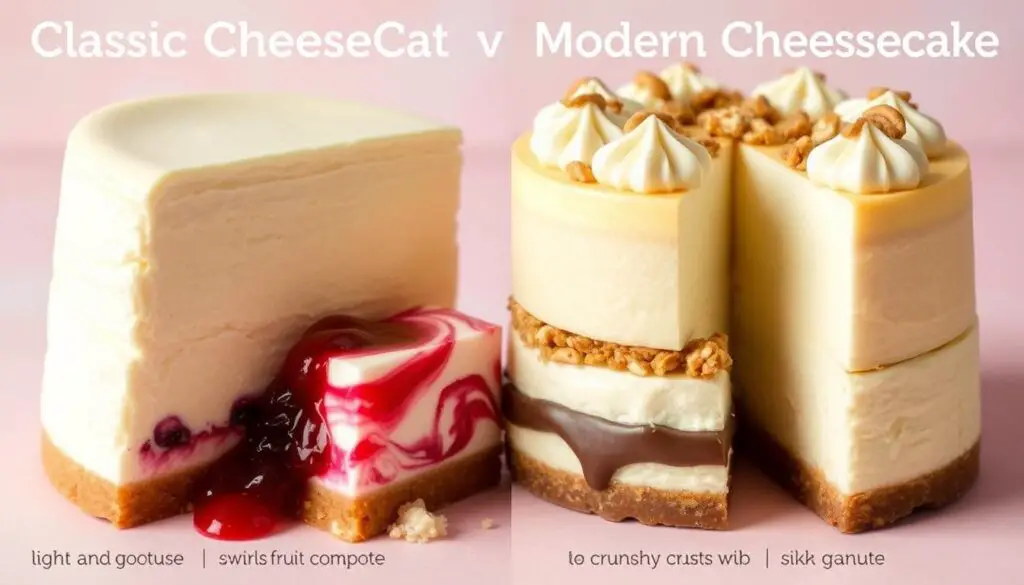
Cultural Cheesecake Trends
Cheesecake has evolved into many forms and flavors worldwide. It shows the variety of tastes and cooking styles across cultures. Each place adds its own twist to this beloved dessert.
In Japan, the souffle cheesecake is light and airy. It’s made with cream cheese, eggs, and flour. This type of cheesecake became popular in the 1950s with the introduction of refrigeration1920. By the 1970s, Japanese commercial chains and women’s magazines helped make it even more popular19.
Cheesecake Around the World
Every country has its own cheesecake tradition. In the United States, cheesecake is loved everywhere, with many flavors to try21. The Greek island of Samos is where cheesecake first appeared, over 2,500 years ago21.
In Japan, the souffle cheesecake is a hit, thanks to its lower calories19. Cheesecakes there often include seasonal ingredients like matcha and yuzu, blending old and new flavors20.
Social Media’s Impact on Cheesecake Trends
Social media has boosted cheesecake trends, encouraging people to try new recipes. Sites like Instagram and TikTok share beautiful cheesecake pictures. From Basque burn cheesecake to new flavors, these posts inspire many to bake1920.
These desserts’ popularity shows how important looks are today. A good photo can make a recipe go viral, proving that a picture is worth a thousand likes.
Cheesecake Recipes for Home Bakers
Are you ready to dive into the world of cheesecake? There’s a wide range of recipes waiting for you. This section offers both classic and modern cheesecake recipes for every skill level.
Traditional Recipes to Try
Classic cheesecakes are always a hit. Here are some timeless recipes to try:
- New York-Style Cheesecake
- Chocolate Ganache Cheesecake
- Pumpkin Cheesecake
- Lemon Bar Cheesecake
- Red Velvet Cheesecake
Exploring Modern Variations
Modern cheesecakes let you get creative in the kitchen. These recipes bring new and exciting flavors:
- No-Bake Mascarpone Cheesecake
- Basque Burnt Cheesecake
- Mini Cheesecakes with assorted toppings
- Fusion Cheesecakes: Pumpkin-Pecan Cheesecake
These recipes offer a mix of flavors and styles. You’ll find everything from chocolate to caramel, and even fruit like strawberries and apples22. No-bake cheesecakes are especially popular, requiring just 20 minutes of active time22. Seasonal fruits like peaches and blueberries are also featured in many of these recipes22.
Looking for something both indulgent and practical? Mini cheesecakes are perfect for baby showers or dessert buffets22. They offer flexibility with different flavors and toppings. Plus, using an Instant Pot can make cheesecake prep quicker22.
Keeping cheesecakes fresh is easy. They can last 5-7 days in the fridge, ensuring you enjoy them fully23. To avoid cracks, baking in a water bath is recommended23.
With so many options, these recipes encourage you to try new things. From traditional favorites to modern twists, there’s something for every baker22 and23.
Conclusion
Cheesecake’s journey from ancient Greece to today is fascinating. It shows how tradition and innovation blend in desserts. Classic and modern cheesecakes offer a wide range of tastes and textures, loved by all ages.
The New York-style cheesecake is a perfect example of this mix. It combines creamy richness with a classic feel. This shows how different places add their own twist to traditional recipes.
New cheesecake types, like Japanese and Basque, add variety to desserts. Places like Junior’s are famous for their cheesecakes, priced at $9 per slice. They show how cheesecake culture is still growing.
Restaurants like MiraMare Ristorante mix Italian and American flavors. They offer dishes like New York Ricotta, showing the rich history of cheesecake in a delicious way24.25
Cheesecake keeps changing, but it’s always a favorite. It’s influenced by social media and big restaurants. The mix of old and new in cheesecake shows the power of culinary creativity26.

